Invested: Australia’s Southeast Asia Economic Strategy to 2040
On the 6th of September in Jakarta, Prime Minister Anthony Albanese released Australia’s Southeast Asia Economic Strategy to 2040 (the Strategy), available here.
By 2040, Southeast Asia is expected to be an “economic powerhouse fuelled by favourable demographics, industrialisation, urbanisation and technological advances”. The region is forecast to sustain a compound average growth rate of 4% until 2040 and a bloc, is projected to be the world’s fourth-largest economy.
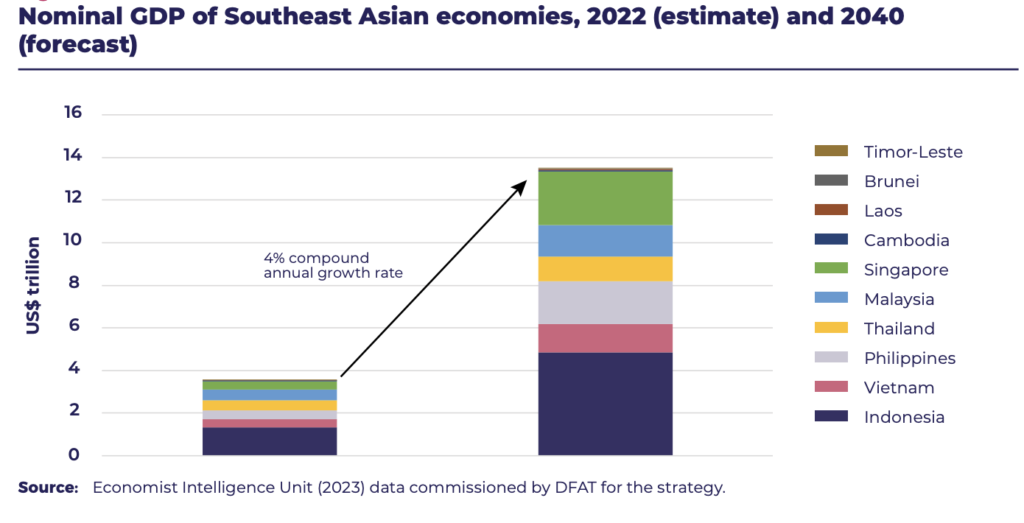
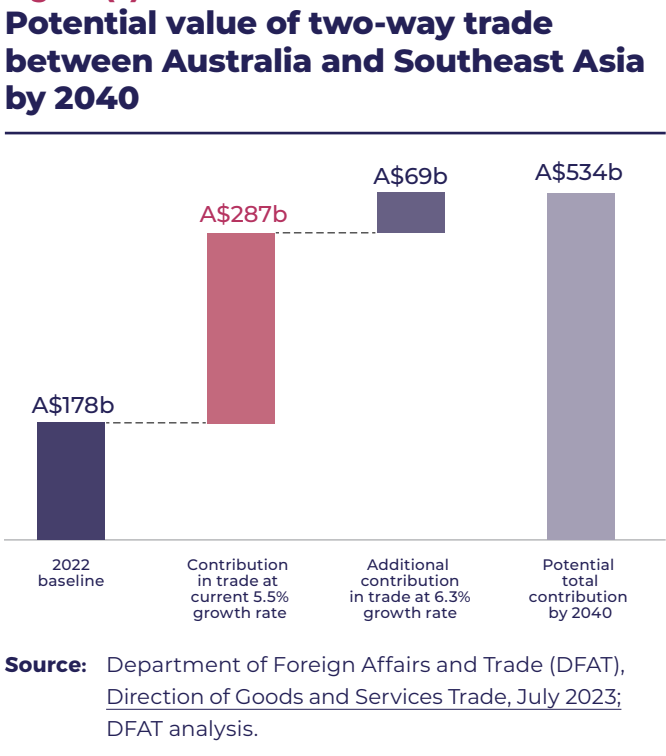
Australia has the opportunity to triple two-way trade with the region to $534bn a year by providing the raw materials for its growth, training its workforce, targeting its expanding middle class and using Australians’ superannuation savings to build its infrastructure.
Currently, 250 exporters make up 90% of Australia’s merchandise exports to Southeast Asia. Thus, the strategy includes 75 recommendations to strengthen Southeast Asia literacy in Australian business, government, the education and training system, and the community.
The recommendations are categorised into four themes:
- Raise Awareness— Strengthen understanding of markets, sectors and emerging trends;
- Removing blockages — Address barriers to trade and investment;
- Build capability — Ensure Australia and the region have the skills and knowledge to work effectively together;
- Deepen investment — Support Australian investors to identify, develop and finalise prospective deals in the region.
The government has committed $95.4 million to fund three initiatives that are central to the strategy:
- Investment Deal Teams ($70.2 million over four years) who will be based in the ASEAN region and will work with Australian investors, Southeast Asian businesses and governments to identify and facilitate investment opportunities.
- Southeast Asia Business Exchange ($19.2 million over four years) to boost two-way trade and support Australian exporters to enter, compete and grow in the fast-growing markets of Southeast Asia. This will include a trade and investment campaign to promote opportunities in Southeast Asian markets to Australian businesses and consumers.
- Placements and Internships Pilot Program for Young Professionals ($6 million over four years) which will help to build enduring links between Australian and Southeast Asian businesses.
Ten priority sectors (listed below) with the most potential for growth, have been identified.
Agriculture and Food
Resources
Green Energy Transition
Infrastructure
Education and Skills
Visitor Economy
Healthcare
Digital Economy
Professional and Financial Services
Creative Industries
Agriculture and Food
Southeast Asia is one of the fastest-growing markets for Australian agricultural exports. There is a growing demand for ‘cleaner’, sustainable and ethically sourced foods as consumers increasingly prioritise health and food safety in their food choices
Collaborative investments can transform Australian raw commodities into higher-value exports for Southeast Asia. Government investment and resourcing can help deliver new and improved market access opportunities for businesses to expand.
The Strategy recommends:
- A targeted, sustained and modern ‘whole-of-nation’ agricultural trade and investment advocacy effort to drive growth.
- Promoting Australia’s environmental, social and governance credentials along the agrifood supply chain.
- Ongoing ministerial engagement on agriculture through ASEAN mechanisms to provide additional forums to reduce barriers to trade.
- Deepening engagement with Cairns Group Farm Leaders in the region (Indonesia, Malaysia, Vietnam, Thailand and the Philippines).
- Expanding resources for technical expertise and frameworks to support Australian export businesses to comply with new and existing import requirements (for example, environmental sustainability and halal) in Southeast Asian countries
- Developing and deepening cooperation on sustainable agrifood systems through existing mechanisms and development programs.
- Expanding training programs to support regional farmers on the world’s best agriculture practices (including water, soil, and broader environment and sustainability practices).
- Providing long-term support for Southeast Asian trading partners’ capacity to address biosecurity threats, including through in-country deployments of specialist technical capabilities
- Establishing an Australian Agriculture Partnership to bring together public and private sector expertise to support agricultural trade cooperation and development in Southeast Asia.
Resources
Southeast Asia’s energy demand has increased by an average of 3 per cent a year over the past two decades and is projected to double by 2050 from 2020 levels. Demand for critical minerals and mining equipment, technology and services needed to electrify and transition Southeast Asia’s economies presents enormous opportunities for Australian exports to the region.
The Strategy recommends:
- Promoting Australia’s capabilities in mining, energy, and METS to support sustainable development in the resources sector in the region.
- Two-way tertiary scholarships in the resources sector to address skills shortages and gender equality, and enhance Southeast Asia’s technical capacity.
- Geoscience Australia work with counterparts on geological surveys, geological storage, hydrogen and geothermal energy, and resource data in Southeast Asia to enhance transparency and support exploration and investment in mineral deposits.
- Institutional capacity building through government-to-government engagement to promote the sustainable development of Southeast Asia’s resources sector.
Green Energy Transition
The transition to a clean energy economy is both the most significant challenge and an opportunity for Southeast Asia and Australia. Australia has the expertise and technology to assist the region with its transition needs, and there is also scope to attract investment to support Australia’s clean energy manufacturing objectives. Diverse and resilient energy supply chains will be critical, and there is potential to collaborate on solar, electric vehicles and battery storage supply chains.
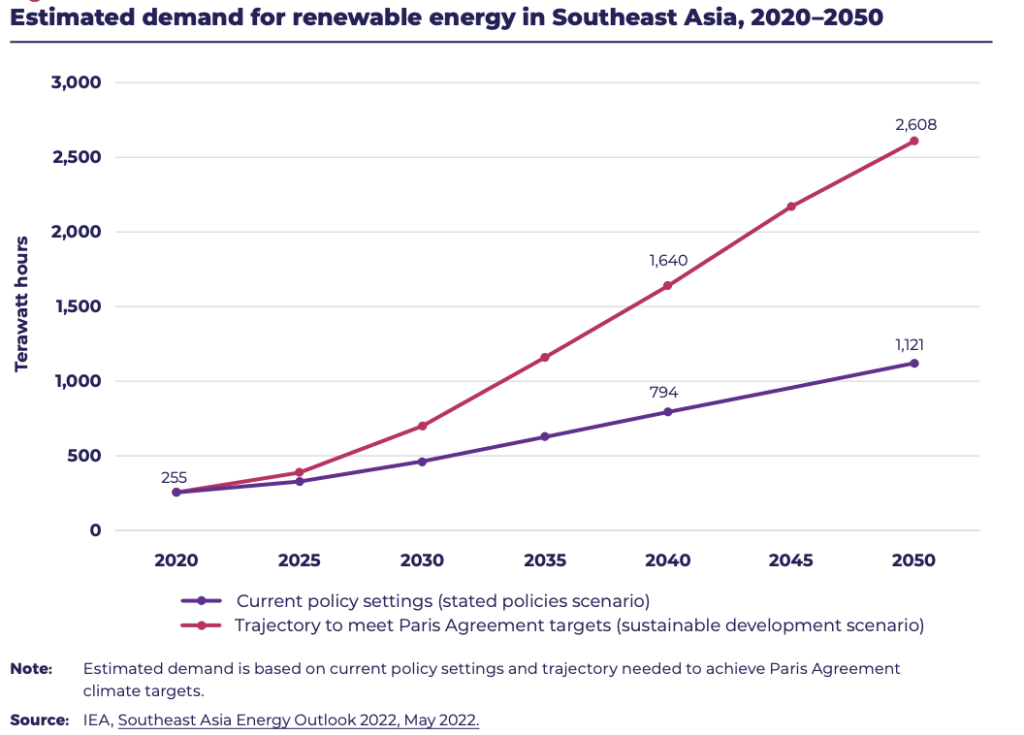
The Strategy recommends:
- That the Australian Treasury lead expanded work with Southeast Asian partners on high-quality and interoperable sustainable finance classifications and climate-related disclosure rules.
- Establishing standards and regulations to allow for a regional market in low-energy goods, including electricity and carbon, with interested Southeast Asian partners.
- Drawing upon regional clean energy supply chain initiatives to support strategic projects involving Australian and Southeast Asian partners in the battery, electric vehicle and solar sectors
- Developing a clean energy science and technology engagement strategy to work with regional counterparts on technical challenges to meet net zero.
- Supporting industry and education and training providers to develop and promote green qualifications for the Southeast Asian market.
Infrastructure
Rapid urbanisation, the growing digitalisation of economies, and the challenges of climate change will all increase the need for greater investment in infrastructure. By 2040, Southeast Asia will need US$3 trillion in infrastructure investment to keep pace with economic and demographic changes and to close infrastructure gaps.
Australia’s deep sectoral expertise provides the opportunity to capitalise on the need for investment in the region’s infrastructure. Assistance from governments across the infrastructure lifecycle, from policy development to project delivery and asset maintenance, will be key to meeting Southeast Asia’s infrastructure gap.
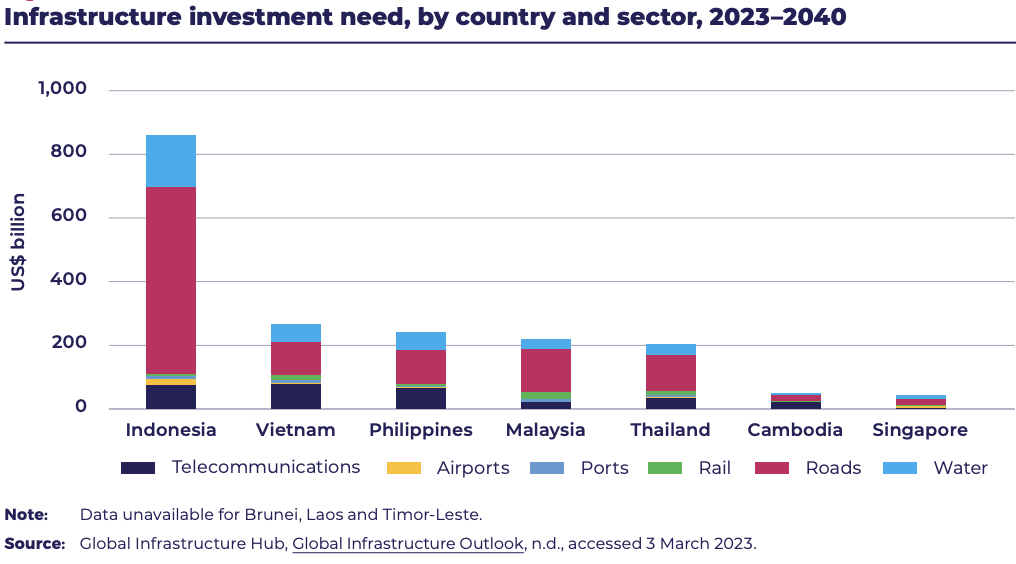
The Strategy recommends:
- Resourcing Australian missions in Southeast Asia to work with partner countries to harmonise regulatory frameworks across the region and lift infrastructure standards to de-risk investments.
- That the Australian Government establish a strategic investment facility for Southeast Asian infrastructure projects, utilising Export Finance Australia and other government-supported funding sources.
- Establishing new investment ‘deal teams’ for Southeast Asia, blending private sector and Australian Government capabilities to provide outward investment (including financing) services.
- Extending partnerships for Infrastructure and expanding early-stage project preparation support.
Education and Skills
Australia’s education sector is a national asset in our engagement with Southeast Asia. Education is one of Australia’s largest services exports to Southeast Asia. The value of education-related travel exports alone was $5 billion in 2022 and the export income from courses was $360 million in 2021–22.
Australian education providers are well placed to supply the increasing demand but will need to be responsive to evolving student preferences and industry needs. Continued investment in Australia’s education offerings, advocacy, alumni and scholarships will help drive Australia’s economic and people-to-people connections with Southeast Asia.
The Strategy recommends that the Australian Government should:
- Invest in education promotion across Southeast Asia to raise awareness of Australia’s offerings and attract more Southeast Asian students.
- Support expanded offshore delivery of education services through further Australian Government advocacy.
- Continue reviewing Australia’s education visa settings to ensure they are competitive and fit for purpose to 2040.
- Expand outbound scholarship and mobility programs to include postgraduates and VET students.
- Seek opportunities for co-financing with universities and sending countries to increase scholarships for Southeast Asian students.
- Encourage universities and vocational education providers to offer work-integrated learning internships as part of course offerings to Southeast Asian students.
- Coordinate a whole-of-nation initiative to better engage alumni, including a scheme for connecting alumni with Australian and Southeast Asian businesses.
- Work with industry to fund a Southeast Asia research grants scheme in areas of mutual interest with Southeast Asia.
- Work alongside Southeast Asian governments to increase cooperation with professional bodies and education providers on qualifications recognition.
Visitor Economy
By 2040, an estimated 181 million Southeast Asians are predicted to travel overseas each year, up from 40.69 million outbound travellers in 2022. The visitor economy contributes significantly to two-way trade, investment and people-to-people links between Australia and Southeast Asia, adding A$2.3 billion and A$4.5 billion to the respective economies in 2022 from visitor spending alone.
Continued investment in marketing, aviation connectivity, infrastructure, visa processing, and training will facilitate increased two-way tourism.
The Strategy recommends:
- Expanding tourism promotion and building industry capability to meet demand.
- Identify opportunities to help build visitor economy data capability in key tourism authorities in the region.
- Government tourism agencies to partner with industry to expand industry-led capability-building initiatives for operators and their employees so that they better understand the cultural preferences and expectations of travellers from Southeast Asia.
Healthcare
As Australia’s and Southeast Asia’s demographics shift towards larger, ageing populations, demand for healthcare will continue to increase. Australian healthcare providers are well placed to meet some of this demand, there will also be opportunities for two-way movement of skilled workers.
The Strategy recommends that the Australian Government:
- Work with the medical industry to expedite efforts towards recognition or reliance arrangements for Australian-made, TGA-approved medical devices and pharmaceuticals in Southeast Asia.
- Work with industry and regulators to identify and address high-priority non-tariff barriers in the health sector.
- Support state and territory governments to work with Australian institutions to develop a health practitioner training program with key Southeast Asian countries.
- Expand the TGA regulatory strengthening program to build the capacity of regional regulators.
- Support regional health policy agencies to build digital health capabilities and policy frameworks, led by CSIRO’s Australian e-Health Research Centre.
- Work with industry to foster stronger connections between medical innovation hubs in Australia and Southeast Asia.
Digital Economy
Southeast Asia’s digital economy is expected to be worth up to US$1 trillion in 2030. In Australia, the benefits of digitalisation should reach up to A$56.7 billion per annum by 2030.
Digital standards, e-commerce and cybersecurity will be key to deepening digital interconnectivity and trade, ensuring inclusive growth benefiting Southeast Asian and Australian businesses out to 2040.
The Strategy recommends that the Australian Government:
- Work with Southeast Asian partners to expand coverage of ambitious digital trade rules and standards and promote interoperability through digital trade rules negotiations, advocacy and capacity building.
- Expand the Cyber and Critical Tech Cooperation Program in Southeast Asia to continue building the cyber resilience of the region.
- Establish Austrade Landing Pads in Indonesia and Vietnam to support Australian tech companies, similar to Austrade’s Landing Pad in Singapore.
Professional and Financial Services
Professional and financial services represent significant exports for Australia, and Australia is well-placed to become a financial centre for Southeast Asia. Southeast Asian professional and financial services are growing quickly, representing great opportunities for investment in fintech and financial inclusion initiatives.
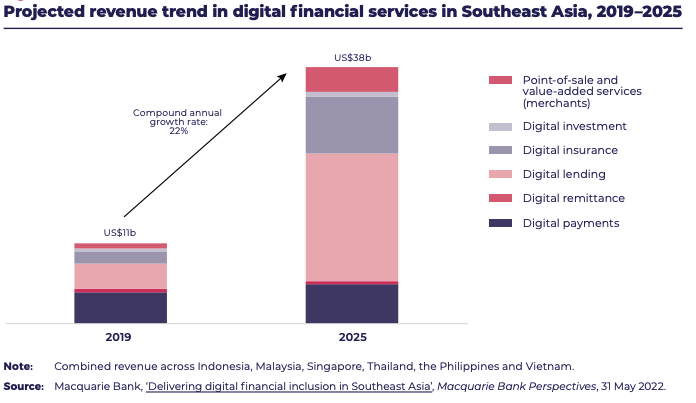
The Strategy recommends:
- Mutual recognition of professional qualifications, licensing and registration in priority professional services sectors, including through advocacy and grants to professional bodies.
- Australian governments and Southeast Asian counterparts work with professional bodies to ensure the digitalisation of credentialing and certification of qualifications.
- Using review mechanisms in Australia’s existing free trade agreements with Southeast Asian countries to remove barriers affecting professional and financial services, such as foreign equity caps and restrictions on the composition of boards and residency of board members.
- Harmonising emerging digital cross-border payment systems.
Creative Industries
Creative industries play an important role in two-way cultural exchange and building people-to-people links, however, engagement between the creative sectors of Australia and Southeast Asia lags behind traditional markets.
Australia and Southeast Asia have a great diversity of creative activity as well as growing consumer bases. There is a role for governments and businesses to support creative exchanges and raise awareness of opportunities
The Strategy recommends:
- Expanding creative industry–focused scholarship or exchange initiatives to create access to a vibrant pool of creative talent in Southeast Asia.
- Encouraging co-productions in the film and digital games industries between Australian and Southeast Asian producers and developers
- Establishing a multi-year seed grants program, drawing on public and private sector contributions, for creative industries collaborative projects, such as residencies, between Australia and the region – including Australian artists with Southeast Asian heritage, and First Nations artists.
- Working with galleries and arts institutions in Southeast Asia to provide access to Australian art, including Indigenous art, from Australian national and state and territory galleries.
For more information, please contact Hawker Britton’s Managing Director Simon Banks on +61 419 638 587.
